the superior physician observes the spirit.
— Huangdi neijing lingshu ⿈帝內經靈樞, Chapter 3, Paragraph 1
Toward a Translation
What are the meridians? Here are some definitions: “The meridians are the channels of qì” (Warren, 2002, p. 1). “The channels and collaterals provide a passage for the circulation of the qi and blood” (Ni, 1996, p. 1). “The meridians and collaterals are pathways in which the qi and blood of the human body are circulated” (Cheng, 2009, p. 63). “The meridian system acts as specific passageways for the circulation of qi and blood throughout the body” (Xu, 2001, p. 50). “Meridians… [are] a system of conduits through which qi and blood circulate” (Men & Guo, 2010, p. 125).
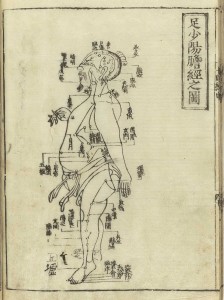 |
| Shaoyang gall bladder meridian of foot 足少陽胆經 |
Thus we have a series of interlocking terms — meridians, channels, passages, pathways, passageways, conduits. All of them raise conceptual problems.
Let me begin with a story. Many years ago, when I was much younger, I used to run — a lot — and suffered a number of the usual running injuries. In fact I became friends with my orthopedist, who eventually wound up operating on both my knees, one for a torn anterior cruciate ligament and one for a torn meniscus. I once went to see him with a nagging pain in my leg. I told him in detail how it felt, where the pain seemed to be located, how the quality of the pain changed when I moved this way or that. He listened carefully, because he was both a good doctor and a friend; and, when I had finished, he nodded and said, “Let’s go get some x-rays.”
There are two ways to look at a human body — as a subject and as an object. I was looking at my body and its pain as a subject, from the inside; my doctor wanted to look at it as an object, from the outside, with what Michel Foucault called, pejoratively, the “medical gaze.” It is not that the doctor found the lived experience of my pain uninteresting; he was, after all, a friend. But it was largely irrelevant to how he perceived his work as a healer.
I think there are several reasons to see the Chinese meridian system as phenomenological rather than physiological. It is a description of what the flow of qì is like from the inside. It is a mistake — a category mistake — either to look for meridians from the outside or to criticize the Chinese for not finding them. It is not that locating physiological meridians would have been uninteresting; the Chinese have a long history of highly empirical science. But it would be largely irrelevant to how they perceive their work as healers.
As Jeremy Ross points out (1985, p. 13), Chinese medicine has had little interest in anatomical structure; its concern has been with bodily processes. Even more, it has been concerned with pathology. In a Chinese medical text there will be some discussion of normal physiology, but the bulk of the text deals with patterns of disharmony and their resolution.
The meridian system as a whole is generally referred to as jīngluò 經絡, a compound word that includes the twelve primary meridians or channels, called jīngmài 經脈; their subsidiary branches or collaterals, called luòmài 絡脈; and the eight extraordinary meridians, called qí jīng bāmài 奇經八脈. There are thus three terms — jīng 經, luò 絡, and mài 脈 — about whose use, writes Ross, “there is considerable vagueness and ambiguity” (1985, p. 9).
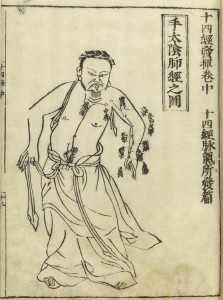 |
| Taiyin lung meridian of hand 手太陰肺經 |
The eight extraordinary meridians and the primary meridians — but not the collaterals — are a type of jīng, although the former are strange qí 奇 and the latter are not. And all three — the primary channels, the collaterals, and the extraordinary channels — are types of mài 脈, a term whose original meaning was not any type of physical structure, but rather the pulse — the felt rhythmic pulsating movement of the substances qì 氣 and blood xuè 血 as they move through the body.
There is also the fact that meridians described in internal practice texts — sometimes anachronistically called texts of qìgōng 氣功, a term that did not exist before 1949 (Voigt, 2013, p. 30) — can differ from those described in medical texts in their location, their direction of flow, their connections, and the size of their acupoints (Liu, 2013, pp. 53-54). This never seems to have particularly bothered anyone. There were not two conflicting objective accounts; there were two different sorts of subjective experience.
Even more telling is the fact that the meridians continue to function even when there is no supporting physical structure at all. “Each meridian continues to operate,” the Acupressure Institute writes, “if the associated organ is removed. This is also true in situations where a limb has been removed. The chi of the meridians extends to where the limb would naturally end” (Warren, 2002, p. 2).
Master acupuncturist Wang Juyi calls the meridians “spaces” jiànxì 间隙 in the body (2008, p. 13) — a term that also means an interval, gap, clearance, spatial distance. Elisabeth Rochat calls them, in one place, a “network of animation” (Larre & Rochat, 1999, pp. 53, 68, 116, 134), and, in another, “the vital circulation” (Rochat, 2009, p. 96). Ted Kaptchuk calls them “an invisible lattice” (2000, p. 105).
Liu Yanchi of the Beijing College of Traditional Chinese Medicine states it plainly: “[T]he channels of Chinese medicine are not analogous to any tangible channel in the human body, such as the veins and arteries. Rather, they are a way of describing the flow of blood, qi (or vital energy), and information that supports the life functions of the body. In this sense, they are more invisible than visible” (1995. p. 95).
Thus, I would not translate either jīng or mài as channel or conduit any of their equivalents. These terms imply a physiological container of some sort — as the dictionary puts it, “a trench, furrow, or groove; a tubular passage for liquids; a pipe or channel for conveying fluids” — which is not what the Chinese term mài seems to connote, and not what the Chinese doctors seem to have been talking about. The same is true for equivalent terms such as passage, pathway, or passageway — themselves defined, in part, as a type of channel through, over, or along which something may pass. It is hard to find an English term that does not convey the sense of a bounded physical object through which qì and xuè pass like physical fluids through a pipe.
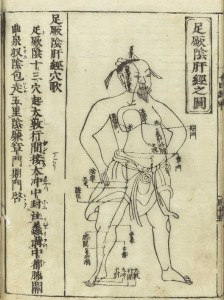 |
| Jueyin liver meridian of foot 足厥陰肝經 |
The term meridian is a little different. Meridian is simply an English reproduction of the French méridien, used by Georges Soulié de Morant for the term mài in his translation of the medical classic Huángdì nèijīng 黃帝內經. I think I know what Soulié de Morant was trying to do with this awkward term. I think he was trying to avoid an otherwise tempting translation, such as the French canal — as in canal cholédoque, bile duct — and instead to analogize the mài to the imaginary meridional lines projected onto the sky or the surface of the earth. As historian Paul Unschuld (2003, p. 370 n. 382) puts it, while being highly critical of the term itself, the term meridians at least “appear[s] preferable to conduits because the former, in contrast to the latter, do[es] not raise any questions as to their own morphological reality and to that of the qi they convey.”
If we could start anew, I would propose the term stream. There are two reasons for this. First, the term does not necessarily imply the existence of a container, either open or enclosed — for example, think of the jet stream or the Gulf stream, which flow through the surrounding medium without the necessity of a container or channel of any sort. Or think of underground water, with which anyone is familiar who has ever dug a well. The water in an aquifer flows, not through a hollow channel, but rather through an underground layer of permeable rock or unconsolidated material such as gravel, sand, or silt — like qì through the permeable flesh.
“A stream is a stream because there is a current as well as the water itself,” writes Elisabeth Rochat. “The water of a stream does not flow everywhere; it is the strength of the current in the stream which makes the stream.” And the mài, she says, are “a kind of force to carry and contain the current.” She points to the trigram kǎn 坎, which is related to water, and which has a strong yang line between two weak yin lines, like this: ☵(Larre & Rochat, 1999, pp. 53, 68) — the current flowing in the stream.
Second, I think perhaps the word stream better reflects the subjective sensation of qì flow — at least for me, to the small extent I have any experience of it — during qìgōng practices such as bāduàn jǐn or dragon gate. Shigehisa Kuriyama (2002, p. 103) puts it this way — that the reality of qì lies in personal experience:
When the doctors in the Neijing spoke of qi rising in anger, sinking in fear, seeping away in sorrow, the weren’t so much trying to explain emotions, objectively, as relating what they knew from their own bodies, describing what they felt, subjectively, within themselves. In anger, a sudden, explosive surge; in grief, a draining away. It was the intimate everyday familiarity of such sensations that made the traditional discourse of vital flux so compelling. The deepest certainties about qì were rooted in knowledge that people had of the body because they were, themselves, bodies.
At the same time, qì is not purely internal; it is subjectively felt but externally manifest, perceptible to the astute physician, reflected in the skin and tongue and pulsations in the mài, even in the tone of voice — in the cíqì 辭氣, literally the qì of one’s speech (Kuriyama, 2002, p. 104).
But, alas, we cannot start anew. The term meridian is widely used, well understood in this context, and has the virtue, as Unschuld has pointed out, of not prejudicing the idea of a physical conduit.
Names and Routes
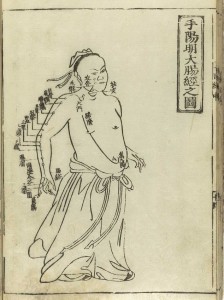 |
| Yangming large intestine meridian of hand 手陽明大肠經 |
In the traditional nomenclature, each of the twelve primary meridians is named for and uniquely associated with one of the twelve zàngfǔ 臟腑. The names of the twelve zàngfǔ appear to refer to anatomical organs in the human body — the liver gān 肝, for example, or the lung fèi 肺 — and at one time they may in fact have done so. In the Huángdì nèijīng língshū ⿈帝內經靈樞, possibly compiled during the first century BCE or CE, the twelfth treatise, entitled Jīngshuǐ 經⽔, “Waterways,” notes that the appearance, size, and capacity of the organs and blood vessels can be determined by dissection after death. This remark is apparently based on actual experience. In the Han Annals 漢書, we read that the emperor Wang Mang 王莾 ordered the dissection of the body of a rebel named Wang Sunqìng 王孫慶 who had been caught by the imperial army. The doctor — who worked together with a skilled butcher — measured the internal organs and inserted bamboo rods into the blood vessels to discover where they began and ended (Nghi, Dzung, & Nguyen, 2002a, p. 343; Cheng, 2009, p. 31; Unschuld, 2010, p. 78; Schnorrenberger, 2013, p. 111).
What were apparently the results of such examinations were reported in the thirty-first treatise of the Língshū, entitled Chángwěi 常委, “Intestines and Stomach,” where we find detailed information concerning the length, diameter, circumference, and capacity of several internal organs. Specific results from such a dissection are also given in section forty-two of the Nanjing 難經, possibly compiled shortly after the Língshū, which includes detailed measurements of the dimensions, capacity, and weight of the liver, heart, spleen, lung, kidneys, and other organs (Nghi, Dzung, & Nguyen, 2002b, pp. 170-172; Flaws, 1999, pp. 84-86; Unschuld, 2013, pp. 78-79).
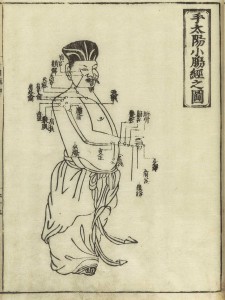 |
| Taiyang small intestine meridian of hand 手太陽小肠經 |
However, after the compilation of the classical Han Dynasty medical texts, interest in the physical anatomy of the human body seems to have rapidly waned and — with a few exceptions — “an anatomical approach was never again pursued seriously” (Unschuld, 2010, p. 79). Rather, each of the zàngfǔ was considered to govern zhǔ 主 a particular bodily process. Thus, for example, the heart xīn 心 governs the xuè and the flow of xuè in the meridians; the liver gān 肝 regulates the volume of circulating xuè and the smooth flow of qì; the kidney shèn 腎 stores essence jīng 精, governs birth, growth, and reproduction, and regulates water in the body; the spleen pí 脾 governs the transportation and transformation of nutrients and keeps xuè flowing in the vessels; and the lungs fèi 肺 govern respiration and controls qì and the downward flow of fluid (Liu, 1988, pp. 75, 77, 79-80, 82, 84-85; Xu, 2001, pp. 20, 22, 25-26, 28-29, 31; Ross, 1985, pp. 65, 83-84, 102, 122, 138).
Note that these descriptions are all partial; each of the zàngfǔ is involved in a wide variety of overlapping processes. But what is important here is that, by metonymy, the process comes to be called by the name of its governing zàng or fǔ. Thus, in any later medical text, and in the contemporary texts of what is called Traditional Chinese Medicine, when we read the name of one of the zàngfǔ, or of the meridian which serves it, we are not reading about a physical organ corresponding to a physical object within the body, but rather about a function or process that is conceptually related to and bears the name of an organ.
And each of these processes, each bearing the name of a zàng or fǔ, and each extended through the body by a specific meridian, becomes correlated — in what Unschuld calls “the medicine of systematic correspondences” — with one of the wŭxíng 五行, and with a season, a time of day, an emotion, a sense organ, and other features of the earthly and heavenly cosmos. As Unschuld puts it (2010, p. 79):
With a rudimentary knowledge of tangible internal organs and various other anatomical entities, such as blood vessels, uterus, and brain, as a substratum, the medicine of systematic correspondence focused its interest on a definition of various functional entities in the organism, on an assessment of the linkages between these functional entities, and, finally, in an analysis of their relationship to the macrocosmic whole of which they were considered to be an integral part.
In addition to the name of the associated zàng or fǔ, the traditional nomenclature of the twelve primary meridians gives us two additional important pieces of information — first, whether it originates or terminates at the hand or foot, and thus whether it runs, respectively, along the arm or the leg; and, second, its degree of its yangness or yinness, and thus whether it runs medially or laterally and anteriorly or posteriorly in the body (Ni, 1996, p. 2). The zàng meridians are all yin, and have three degrees or levels of yinness — Greater Yin tàiyīn 太陰, Lesser Yin shǎoyīn 少陰, and Faint Yin juéyīn 厥陰; the fǔ meridians are all yang, and have three degrees or levels of yangness — Greater Yang tàiyáng 太陽) Yang Brightness yángmíng 陽明, and Lesser Yang shǎoyáng 少陽. So the twelve primary meridians are named:
- Taiyin Lung Meridian of Hand 手太陰肺經
- Shaoyin Heart Meridian of Hand 手少陰心經
- Jueyin Pericardium Meridian of Hand 手厥陰心包經
- Shaoyang Sanjiao Meridian of Hand 手少陽三焦經
- Taiyang Small Intestine Meridian of Hand 手太陽小肠經
- Yangming Large Intestine Meridian of Hand 手陽明大肠經
- Taiyin Spleen Meridian of Foot 足太陰脾經
- Shaoyin Kidney Meridian of Foot 足少陰肾經
- Jueyin Liver Meridian of Foot 足厥陰肝經
- Shaoyang Gallbladder Meridian of Foot 足少陽胆經
- Taiyang Bladder Channel of Foot 足太陽膀胱經
- Yangming Stomach Channel of Foot 足陽明胃經
These two pieces of information tell us, at least in a general way, where the meridians run. Note the following rules:
The medial-lateral axis: The yin meridians are relatively medial — that is, along the soft surfaces closer to the midline of the body; and the yang meridians are relatively lateral — that is, along the harder and bonier surfaces toward the outside of the body. Thus the zàng meridians, which are all yin, run along the medial aspect of the limbs, and the fǔ meridians, which are all yang, run along the lateral aspect.
The anterior-posterior axis: Taiyang meridians run posteriorly, shaoyang meridians run centrally, and yangming meridians run anteriorly along the limbs; and, similarly, shaoyin meridians run posteriorly, jueyin meridians run centrally, and taiyin meridians run anteriorly along the limbs.
Origination, direction, and termination: The yin meridians flow upward and the yang meridians flow downward; and the yin meridians originate or terminate in the thorax, and the yang meridians originate or terminate in the head. For this purpose, the hands are always considered to be above the head. Thus the foot yin meridians begin at the feet and flow up to the thorax; and the hand yin meridians begin in the upper thorax and flow up to the fingers. Similarly, the foot yang meridians begin in the head and flow down to the toes; and the hand yang meridians begin at the fingers and flow down to the head (Cheng, 2009, p. 64; Ni, 1996, p. 2; Warren, 2002, p. 2). In summary:
| Zangfu | Type | M-L Axis | A-P Axis | Direction | From | To |
|---|---|---|---|---|---|---|
| Bladder | Taiyang | Lateral | Posterior | Downward | Head | Foot |
| Small Intestine | Taiyang | Lateral | Posterior | Downward | Hand | Head |
| Gall bladder | Shaoyang | Lateral | Central | Downward | Head | Foot |
| Sanjiao | Shaoyang | Lateral | Central | Downward | Hand | Head |
| Stomach | Yangming | Lateral | Anterior | Downward | Head | Foot |
| Large Intestine | Yangming | Lateral | Anterior | Downward | Hand | Head |
| Kidney | Shaoyin | Medial | Posterior | Upward | Foot | Thorax |
| Heart | Shaoyin | Medial | Posterior | Upward | Thorax | Hand |
| Liver | Jueyin | Medial | Central | Upward | Foot | Thorax |
| Pericardium | Jueyin | Medial | Central | Upward | Thorax | Hand |
| Spleen | Taiyin | Medial | Anterior | Upward | Foot | Thorax |
| Lung | Taiyin | Medial | Anterior | Upward | Thorax | Hand |
So we know, just from its name, that the taiyin lung meridian, for example, runs upward from the thorax medioanteriorly to the fingers, and that the shaoyang gallbladder meridian of the foot runs downward from the head laterocentrally to the toes. Specific routes and acupressure points require a map, such as those illustrating this post.
REFERENCES
Cheng Xinong (2009). Chinese acupuncture and moxibustion. Beijing: Foreign Languages Press.
Flaws, Bob (Trans.). (1999). The classic of difficulties: A translation of the Nan Jing. Boulder, CO: Blue Poppy Press.
Kaptchuck, Ted (2000). The web that has no weaver: Understanding Chinese medicine (2nd ed.). New York: McGraw-Hill.
Kuriyama, Shigehisa (2002). The expressiveness of the body and the divergence of Greek and Chinese medicine. New York: Zone Books.
Larre, Claude, & Rochat de la Vallée, Elisabeth (1999). Essence spirit blood and qi. Bodmin and King’s Lynn, England: Monkey Press.
Liu Yanchi (1988). The essential book of traditional Chinese medicine. Volume I: Theory. New York: Columbia University Press.
Liu Tienjun (2013). Chinese medical qigong. London: Singing Dragon.
Men Jiuzhang & Guo Lei (2010). A general introduction to traditional Chinese medicine. Boca Raton, FL: Science Press.
Nghi, Nguyen Van, Dzung, Tran Viet & Nguyen, Christine Recours (Trans.). (2002a). Huangdi neijing lingshu: Volume I, Books I – III. Sugar Grove, NC: Jung Tao School of Classical Chinese Medicine.
Nghi, Nguyen Van, Dzung, Tran Viet & Nguyen, Christine Recours (Trans.). (2002b). Huangdi neijing lingshu: Volume II, Books IV and V. Sugar Grove, NC: Jung Tao School of Classical Chinese Medicine.
Ni Yitian (1996). Navigating the channels of traditional Chinese medicine. San Diego: Oriental Medicine Center.
Rochat de la Vallée, Elisabeth (2009). Wu xing: The five elements in Chinese classical texts. Bodmin and King’s Lynn, England: Monkey Press.
Ross, Jeremy (1985). Zang fu: The organ systems of traditional Chinese medicine (2d ed.). Edinburgh: Churchill Livingstone.
Schnorrenberger, Claus C. (2013). Anatomical roots of Chinese medicine and acupuncture. Schweizerische Zeitschrift für Ganzheitsmedizin, 25, 110–118
Twicken, David (2013). Eight extraordinary channels, qì jing ba mai: A handbook for clinical practice and nei dan inner meditation. London: Singing Dragon.
Unschuld, Paul U. (2003) Huang di nei jing su wen: Nature, knowledge, imagery in an ancient Chinese medical text. Berkeley: University of California.
Unschuld, Paul U. (2010). Medicine in China: A history of ideas. Berkeley: University of California Press.
Voigt, John (2013, August). The man who invented “qigong.” The Journal of Traditional Eastern Health & Fitness, 23(3), 28-33.
Wang Juyi & Robertson, J. (2008). Applied channel theory in Chinese medicine: Wang Ju-Yi’s lectures on channel therapeutics. Seattle: Esastland Press.
Warren, Wendy (2002). Intermediate and advanced acupressure course booklet. Berkeley: Acupressure Institute.
Xu Xiangcai (2001). Principles of traditional Chinese medicine. Boston: YMAA Publication Center.

- Previous Post: Sex with the Shaman
- Next Post: Ayahuasca and Addiction
- More Articles Related to: Research Studies


